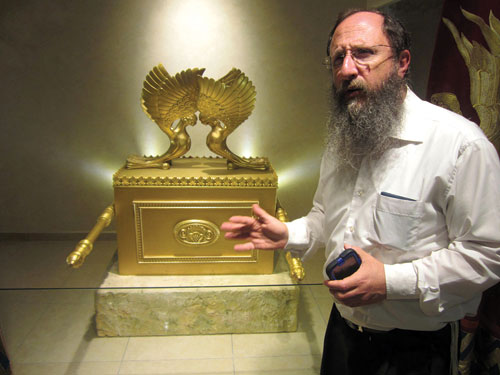.jpg)
Jerusalem—As the Jewish calendar passes Chanukah and continues into the month of Tevet, an unusual transformation unfolds. Less than two weeks ago, Jews worldwide were celebrating a holiday of victory and unity, of rebuilding and returning. Yet on the tenth day of Tevet, these same individuals are in mourning.
Over two millennia ago, Asara b’Tevet was the beginning of the end of the first Temple, when Nebuchadnezzar, king of Babylon, began his siege on Jerusalem ending with the ultimate destruction of the holy structure and exile of the Jews from Israel. Even now, about 2600 years later, as the city that Nebuchadnezzar besieged has since been rebuilt and modernized, we still fast on this tragic day. To help those who have difficulty reconciling the conflicting feelings of destruction and reconstruction, JLBC visited Mechon Hamikdash (The Temple Institute), a unique organization whose sole purpose is to rebuild what has been twice destroyed—one piece at a time.
Mechon Hamikdash is rebuilding the Bet Hamikdash in the belief that “if you build it, he (the Messiah) will come,” an idea backed by no less than 30 different positive commandments in Leviticus, and most commentators on the Torah and the Talmud.
The Institute was founded by Rabbi Yisrael Ariel in 1987 in the Jewish quarter of Jerusalem’s Old City. Rabbi Ariel was among the first soldiers to reach the Temple Mount when it was liberated by General Motta Gur on June 7, 1967. He is now considered to be a foremost expert on everything related to the Bet Hamikdash, and opened the Mechon in the hope of realizing the dream of building the Third Temple.
Rabbi Chaim Richman, the director of Mechon Hamikdash’s International Department, explained Rabbi Ariel’s mission: “In Exodus 25:8 G-d commands the Jewish People ‘And you shall make me a temple and I will dwell in it.’ This is a positive commandment… amongst tens of other action-oriented mitzvot (commandments) in the section. What does this mean exactly? That we should be as actively involved in the construction of the Holy Temple as possible.”
The Institute strives to rebuild all of the utensils of the Temple, such as the Menora, Shulchan, Mizbeach, and even a model of the Aron Habrit. At first, many, especially those from Ultra-Orthodox communities, hesitated to embrace Mechon Hamikdash’s projects. However, as time has gone on, people have warmed up to this idea of reconstruction, to the extent that Mechon’s Menora is now on permanent display in the Kikar Hamenora (Square of the Menora) viewing area overlooking the Kotel and Har Habayit. Israeli politicians and dignitaries have also taken to visiting the Temple Institute to show their support.
In addition to research and development in recreating the Temple artifacts, Mechon Hamikdash is dedicated to spreading awareness of the Bet Hamikdash, the political situations surrounding the Temple Mount and the future of the Jewish people. Rabbi Richman, scholar and veteran of the Temple Institute for over 25 years, heads a team of English-speakers that go on speaking tours throughout the United States and Israel’s Anglo communities, presenting in schools and synagogues.
They also have an extensive website featuring different resources on the history and future of Jerusalem and Israel, several video series hosted on YouTube and many different book series. Rabbi Richman told JLBC that he is in the process of filming several short videos on the halakha issues surrounding their projects and working on an English language book about rebuilding a Holy Temple. Both projects have been generously funded by a donor in East Brunswick, NJ.
Rabbi Richman gave the JLBC his observations about Asarah B’Tevet:
“Chanukah, which we just celebrated, is the only holiday on the Jewish calendar to bridge between two months. There is an idea that the monthly calendar is focused around its beginning, and it is no coincidence that the month where we mourn the beginning of the end starts with a bright beginning. In theory Tevet should be a happy month—the prophet Zecharia teaches that in the times of the final redemption, Asara B’Tevet will be a day of mourning that will become a day of celebration. Eventually, the destruction of the First Temple will be commemorated as a stepping stone for something bigger; the Third Temple.
“But, what’s stopping us? A pattern of complacency. We’ve become so used to mourning that we find it difficult to stop even though we now have a chance to rebuild. Tevet shouldn’t be focused on sadness, and if we focus our efforts on the rebuilding of the Holy Temple then next year, with God’s help, we will go from the holiday of Chanukah to the holiday of Asara B’Tevet.”
“Even as we mourn the siege of Jerusalem and the start of the first expulsion, we can’t forget that the end the exile is near, and the final redemption is almost upon us. Mechon Hamikdash reminds us of the all-important lesson: “if you build it, he will come.”
Visit Mechon Hamikdash’s English website http://www.templeinstitute.org/ and check out their facebook page.
By Tzvi Silver













